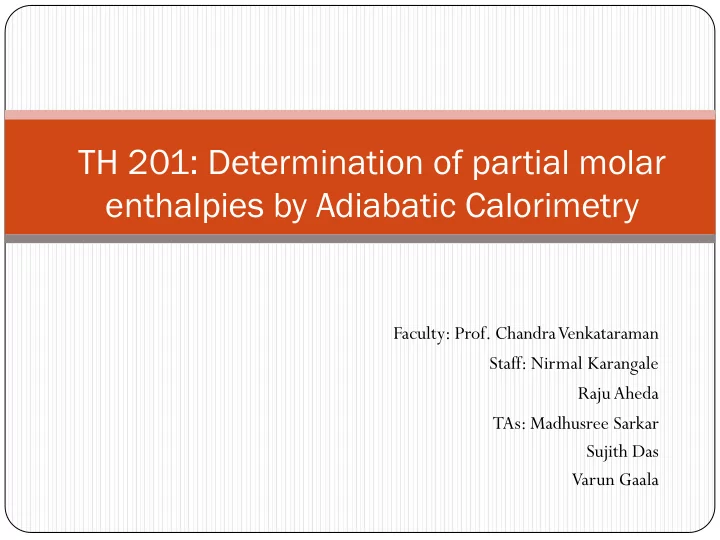

TH 201: Determination of partial molar enthalpies by Adiabatic Calorimetry Faculty: Prof. Chandra Venkataraman Staff: Nirmal Karangale RajuAheda TAs: Madhusree Sarkar Sujith Das Varun Gaala
Objectives To determine heats of mixing of binary systems by adiabatic calorimetry To determine partial molar enthalpies of the two components To test whether a given hypothesis holds true
Principle Calorimetry: Involves measurement of enthalpy changes of chemical reactions or physical changes as well as heat capacity using the principle of conservation of energy. Here adiabatic calorimetry is employed. Thus, there is no heat exchange with the surroundings. Temperature change monitored.
Theory Partial molar properties: Thermodynamic properties that vary with the molar composition of the components. Helps understand properties of components in a mixture. Heat of mixing: Amount of heat exchanged when two components are mixed.
Diagram of the Setup Fig: Adiabatic Calorimeter D = Dewar Flask of capacity 150 ml, S = Polypropylene Stopper, H = Resistance Heater, ST= Stirrer, T = Temperature Sensor
Procedure
Calculations For a heating coil : Q IVt For known amount of heat, Q (Joules) is supplied to calorimeter containing water if Δ T is the observed temperature change, then: Q mC T K T P Combining the above equations by assuming perfectly adiabatic conditions: IVt mC T K T P The heat evolved due to mixing: Q mC K T m P m The heat of mixing Δ hm is given by: Q m h m ( n n ) 1 2 Partial molar enthalpies are given by : d h d h m m h h x h h x 1 m 2 2 m 1 dx dx 1 1
Results and graphs Δ Tmix vs Mole fraction of water Cp of mixture vs Mole fraction of water Δ Hmix vs Mole fraction of water Interpretation of results and graphs with uncertainties Note: To test the hypothesis given, additional measurements/calculations may be required, e.g. Measurement and reporting of temperature with respect to time to check if the calorimeter is indeed adiabatic
Precautions Care should be taken so that "heat leak" does not occur through either the lid of the Dewar flask or openings in the lid. While heating, the mixture should be constantly stirred for temperature uniformity
Reporting Introduction Aim including the hypothesis to be addressed Schematic of apparatus Method Explanation of theory Calculation flowchart and sample calculation Uncertainty in measured and calculated values Findings Plots and discussion Interpretation Whether hypothesis was proved true/ false Suggest improvements in rig/calculation method
Thank you
Recommend
More recommend